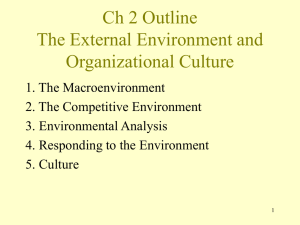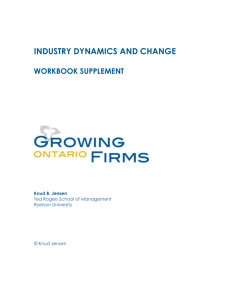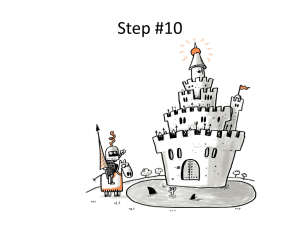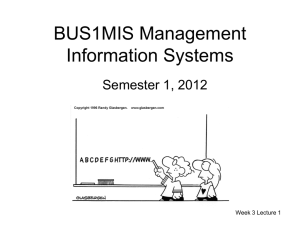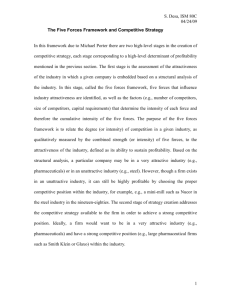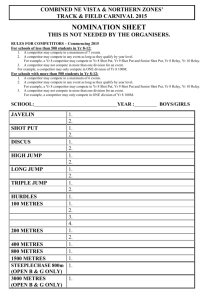Industry - Fox School of Business
advertisement
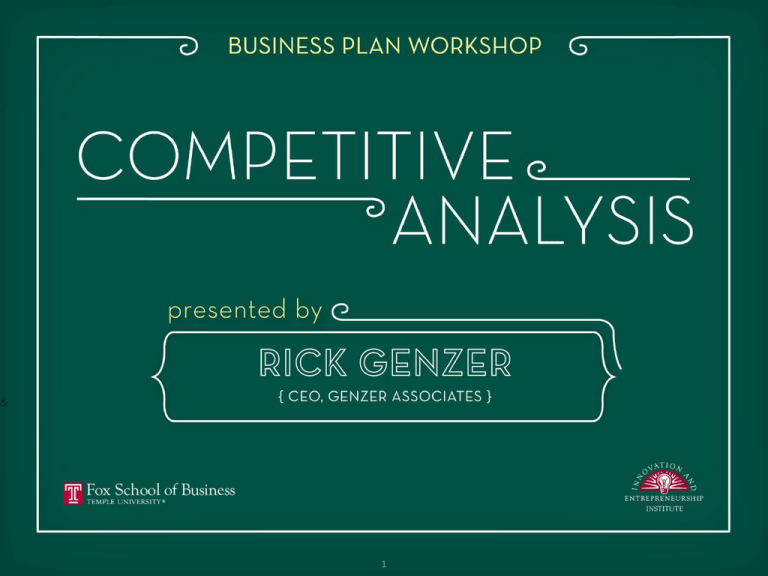
1 Business Plan Outline • Executive Summary • Company Description – Including product/service & technology/core knowledge • Industry Analysis & Trends • Target Market • Competition • Strategy/Business Model • Marketing and Sales Plan • Production/Operations Plan Technology Plan Management & Organization Social Responsibility Development & Milestones Financials Including Capital Requirements & Financial Statements Appendix http://www.fox.temple.edu/cms_research/institutes-and-centers/innovation-entrepreneurship-institute/ http://www.fox.temple.edu/cms/wp-content/uploads/2012/03/2011BYOBBTemplate.pdf Write a Business Plan…In No Time by Frank Fiore 2 Opening Discussion • Do you really know what makes a product or service unique in a market? Do you think customers know the difference? • What market would you like to compete in? How well do you know that market? Who are the key players in that market? • Do you know all the possible places you might get your raw materials, supplies, data, etc.? Do you know who or where your competition might get theirs from and at what cost, time or quality? • Do you have a roadmap for products, services, features, etc.? If so, what justification(s) did you use to generate the list? How does this compare with others in that market or industry? • Does the Internet change anything in regard to these questions? • Pick a business… articulate who their competition is and what you think they are doing to compete. Do you think they could do better? If so, how? Why? Why not? 3 Strategy Funnel This has been in Fox decks for a while. I stared at this for a long time and didn’t understand it for a long time. Now I get it Environmental Trends Customer & Benefits Market Industry Structure Segment, Size Channels Competitive Space Perceptual Space Competitive Dynamics Value Proposition Strategic Positioning 4 Industry Why Strategy Funnel Competitive Analysis COMPETITION INDUSTRY Industry Structure Competitive Space Competitive Dynamics Define Understand Address Customer Segment, Size, Channel Perceptual Space Value Proposition Who Where How What & How Much 5 Strategic Position POSITION Develop Market vs. Industry INDUSTRY • MARKET: the area of economic activity in which buyers and sellers come together and the forces of supply and demand affect prices • INDUSTRY: a distinct group of productive or profit-making enterprises Discussion: Compare / contrast 6 Market Structures INDUSTRY Seller Market Structure Entry Barriers Buyer Number Entry Barriers Number Perfect No Many No Many Monopolistic No Many No Many Oligopoly Yes Few No Many Oligopsony No Many Yes Few Monopoly Yes One No Many Monopsony No Many Yes One Why are we talking about this? 7 Porter’s Generic Value Chain INDUSTRY Primary Activities Inbound Logistics Operations Outbound Logistics Marketing & Sales Support Activities Firm Infrastructure Human Resource Management Technology Development Procurement 8 Service More Simply… INDUSTRY Suppliers Company Customers Improving the chain… Sample Inputs: Technology / Purchasing / Product People / Management Infrastructure / Logistics / Distribution Service •Can your suppliers add value? •Can you add value to supply? • If so, where? •Can you add more? • If so, where? •Will your customers notice? Does your product or service add value sufficient to justify the margin? 9 From Value Chains to Markets INDUSTRY Suppliers Company Customers Value • As underlying processes become more complex, supply chains often evolve into chains of firms that interact through negotiated transactions or markets - rather than chains of functions managed internally • Note how the margin divides (and multiplies) 10 Markets & Industries INDUSTRY • Each cluster of competitors is an industry, industry segment or strategic group • Supply chains and industries evolve over time – as do their rules, cultures, technologies and sources of value 11 Book Selling Commerce Chain INDUSTRY Promotions Packager Author Agent Sales Groups Publisher Wholesaler 12 Retailer Book Selling Commerce Chain INDUSTRY $0.375 Promotions $0.45 $0.375 Packager Author $0.50 Agent $0.05 Sales Groups Publisher Wholesaler $3.50 $1.00 Retailer $5.50 $12.00 13 Book Selling Commerce Chain INDUSTRY Packager Author Agent Sales Groups Publisher Wholesaler Retailer Direct Marketing Harper & Row Barnes & Nobel Ingram 14 Industry Structure INDUSTRY • Industries are clusters of firms that serve the same function in a commerce chain. These sets of firms operate in the same space and compete to control enough space to capture value. • Industries all have structure, history, trajectories and competitive dynamics that constrain entry options – and are shaped in part by macro-environmental conditions. 15 Stakeholder Analysis INDUSTRY • Stakeholder – Any person or organization that is impacted • Analysis – Who/what is impacted and by how much • Who – Customers, suppliers, owners, workers, community groups, government • What – Finance, time, product, supply, margin, market share • When – How often is the impact felt and for how long • Response – What can/should/will they do about it 16 Exercise Draw the chain, Identify your industry… INDUSTRY COMPETITION • Who sells what to whom? – Ask industry informants, look at customer and supplier lists, read trade journals, search the Internet • Draw what you see • Circle your industry – Be sure to include a functional cluster of firms • Identify sources of competition – Direct competitors from within the industry – Indirect competitors from related supply chains or industry • Note the supply market • Note the demand market 17 Porter’s Rivalry COMPETITION • How are you positioned as compared to: New Entrants Suppliers Industry Rivalry Buyers Substitutes – Possible new entrants – Existing suppliers – Likely substitutes for your product – Buyers that (don’t) know what they want • How will customers react to changes? 18 Rivalry Example: Physical Bookstores COMPETITION • New Entry is local – Store locations – Warehousing costs • Suppliers can be locked up – Exclusivity arrangements – Direct from authors or printers • Substitutes abound What has happened to this industry? Why? What would you have done? – Amazon – Electronic books – Library 19 New Entrants COMPETITION • Industries that are hard to enter are cozy for insiders, but also often attractive to outsiders longing for the value being shared by so few. • Barriers to entry make it harder for newcomers to play. – – – – – Fierce reaction by incumbents (e.g. lawsuits over IP) Capital (e.g. building a chip foundry) Economies of scale (e.g. building a sales network) Existing customer loyalty (e.g. Coke) Application stickiness (e.g. learning curve or cost) 20 Buyer Power COMPETITION • Some attractive industries feature disorganized, small customers, with little purchasing and negotiating power – How has the Internet changed this? – What about a niche? • Buyers gain power when: – They are large, relative to the seller (e.g. superstores) – They are organized (e.g., a coop) – It is easy to switch to another supplier (e.g., when products are standard… try comparing mattresses or house brands) 21 Substitutes COMPETITION • Number – Industries with few substitute products are more attractive than those with many substitutes • Opportunity – Effective substitutes can often provide opportunities for upstarts • Threat – Just the threat has impact…weakest of the forces – except during times of high demand or fast change, when interlopers may see opportunities • Industry killers – Netflix to video store, Amazon to book stores 22 Supplier Power COMPETITION • Attractive industries feature small and disorganized suppliers • Suppliers gain power when: – They are large, relative to the buyers. (e.g. Alcoa). – It is difficult for buyers to switch to competing suppliers. (e.g. custom products, proprietary information) – They pose a credible threat of integrating forward and taking over the buyers’ functions (e.g. direct sale or drop ship) 23 Rivalry COMPETITION • Attractive industries are controlled by monopolies or gentlemanly oligopolies. – On the other hand, the more the players, and the more equally matched, the closer the industry approximates “perfect competition” and minimum profits. • Rivalry is reduced when: – – – – – Power is concentrated Competitors can truly differentiate. It is easy to exit. Demand is stable and predictable. Regulation takes the edge off. 24 STEEP Analysis COMPETITION Social • How do these forces effect your business? • Understand your operating environment Operating Environment Technical – Community, local politics, unions Organization Economic • How is your organization positioned to handle this Ecologic – Structure, competencies, finance Political • How do you compare with your competition? Also: PEST: Political, Economic, Social, Technology SLEPT: Social, Legal, Economic, Political, Technology STEER: Social, Technology, Economic, Ecologic, Regulatory STEEPLE: Social, Technology, Economic, Environmental, Political, Legal, Ethical 25 Profit Pools: Retail Bookselling COMPETITION What do we learn? • • • Author Paper Operating Margin 40% Where would you like to compete? Who makes the most? What else do we need to know? Distributor * completely made up #’s / %’s Retailer Publisher Share of Industry Revenue 26 100% Competitive Analysis POSITION • Competitors are the firms that compete to serve the same customers in the same marketplace. • Competitors can compete directly (cars) or indirectly (bicycles, mass transit). • Competition happens on two levels: – Product or service competition • Competition at the level of the value proposition and marketing (covered in the first workshop) – Company competition • Competition at the level of company strategy 27 Company Competitive Analysis POSITION • How does each firm compete – Ex. quality, service, price, features • How effective is each – Ex. feature list, comparative quality Think back to the value chain! • How strong or powerful – What resources do they control? Are other’s able to compete? (e.g. market structure, exclusivity) • How aggressive – How hard do they compete? What’s their trajectory? 28 Competitors Table Organizes competitors using crucial dimensions of competition, plus effectiveness, power, trajectory, likely changes... Market Share Quality Cost Effectiveness Power Competitor 1 15% H H M M Competitor 2 25% L L H H Competitor 3 5% M M L L Competitor 4 20% L L H H Competitor 5 15% M M H L What other variables might you use? 29 Aggressiveness very slipping POSITION Competitor Response Profile POSITION Drivers Abilities Future Goals Vision statement Managerial behavior Current Strategy Price, quality, distribution, resources Critical Assumptions Key beliefs Blind spots Response Profile Satisfied or ambitious? Likely next moves? Vulnerabilities? Sensitive spots? (What will provoke retaliation?) 30 Capabilities Strengths & weaknesses Strategic Groups Groups of firms that pursue similar strategies with similar resources Price Upscale Chains Diners/Family Style Fast Food Selection 31 POSITION Gartner’s Magic Quadrant POSITION Leaders Execution Challengers Niche Players Visionaries Other Possible Quadrants… •Satisfaction vs. Importance •Urgent vs. Importance •Quality vs. Cost •Risk vs. Value Vision 32 GARTNER MAGIC QUADRANT POSITION • Gartner rates vendors upon two criteria: completeness of vision and ability to execute. – Leaders score higher on both criteria; the ability to execute and completeness of vision. Typically larger industry developed businesses with vision and potential for expansion. – Challengers score higher the ability to execute and lower on the completeness of vision. Typically larger, settled businesses with minimal future plans for that industry. – Visionaries score lower on the ability to execute and higher on the completeness of vision. Typically smaller companies that are unloading their planned potential. – Niche players score lower on both criteria: the ability to execute and completeness of vision. Typically new additions to the Magic Quadrant, or market fledglings. 33 Dynamic Competitor Analysis POSITION • While useful, the competitor table and the strategic groups are essentially static. • It is critical to make guesses about the future -especially about when trends might stop and the ground might shift, and when new competitors might rise, or existing ones die. 34 Exercise: Competitor Analysis POSITION • Make a competitors table, including: – – – – – market share how they stack up on crucial dimensions of value effectiveness (star the most competent ones) resources (underline richest ones) aggressiveness (arrows to indicate trajectories) • Note any natural groupings • Note any likely changes – New entrants, mergers, exits? 35 Review • Industry – How is it structured, where is the value created and at what margins? • Competition – Who are they, what value to their bring and how strong is the competition? • Position – Where do you fit and on what criteria will you compete? 36 BIBLIOGRAPHY • • • • • • • • • • • • • • • Andersen Business Consulting interview, Summer 2001. Richard D’Aveni, Hypercompetition (Free Press: 1994). Craig Fleisher & Babette Bensoussan, Strategic & Competitive Analysis: Methods & Techniques for Analyzing Business Competition (Upper Saddle River, NJ: Prentice Hall, 2003) Jay Galbraith, “Strategy & Organization Planning” in Human Resource Management (SpringSummer 1983) for Supply Chain. Pankaj Ghemawat, Strategy and the Business Landscape (Prentice Hall, 2001). Robert Hamilton lecture notes, 1998. Robert Hamilton, E. Eskin, M. Michael, "Assessing Competitors: The Gap between Strategic Intent and Core Capability", International Journal of Strategic Management-Long Range Planning, Vol. 31, No. 3, pp. 406-417, 1998 TL Hill lecture notes, 1999, 2001, 2002. J. D. Hunger & T.L. Wheelan, Essentials of Strategic Management (Prentice Hall, 2001). Philip Kotler, Marketing Management, 9th Edition, (Prentice Hall, 1997). Sharon Oster, Modern Competitive Analysis, 2nd Edition (Oxford University Press, 1994), for Porter and other economics-based strategy. Henry Mintzberg & James Brian Quinn, Readings in the Strategy Process, 3rd Edition (Prentice Hall, 1998). Michael Porter, Competitive Advantage (Free Press, 1985). Michael Porter, “What is Strategy?” Harvard Business Review (November-December 1996). Wikipedia, Gartner Magic Quadrants, Market Definitions February 2011 37



